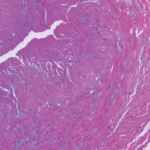Giant cell arteritis (GCA)—a type of vasculitis—is a group of diseases whose typical feature is inflammation of blood vessels. The blood vessels most commonly involved are the arteries of the scalp and head (especially the arteries over the temples), which is why another term for GCA is “temporal arteritis.” GCA can overlap with another rheumatic disease called polymyalgia rheumatica, and symptoms of the two conditions can occur at the same time or separately. The causes of GCA and polymyalgia rheumatica are unknown.
GCA affects older adults (usually older than age 60), females more than males, and Caucasians more than other races. The most common symptom of GCA is a new headache, usually in the area of the temples. Almost as common are more generalized symptoms, such as unusual fatigue, loss of appetite, weight loss, a flu-like feeling, or fevers. Occasionally, the only indication of GCA is a recurring, prolonged fever. Less common symptoms involve facial, tongue, or throat pain and pain in the jaw when chewing. If GCA spreads to the blood supply of the eye, vision can be affected. Visual symptoms include temporary blurring, double vision, or actual blindness.
GCA can be difficult to diagnose and requires prompt treatment to preserve vision. Rheumatologists are specialists in musculoskeletal disorders and, therefore, are more likely to make a proper diagnosis of GCA. Unfortunately, there is no noninvasive way to confirm the diagnosis. According to William Docken, MD, author of the patient fact-sheet, “It is common to recommend a biopsy of a small piece of the temporal artery, which is then examined under the microscope for evidence of inflammation. This outpatient procedure is done under local anesthesia and leaves only a small scar, which generally cannot be seen, at the hairline in front of the ear.”
When a patient is diagnosed with GCA, treatment should begin as soon as possible due to the risk of vision loss. High doses of corticosteroids are usually given for the treatment of GCA. A typical corticosteroid treatment for GCA would be 40 to 60 mg of prednisone per day.
For most patients with GCA, headaches and other symptoms subside quickly and the sedimentation rate declines to a normal range. High-dose corticosteroid treatment typically lasts one month and then is slowly decreased. After treatment, subsequent recurrences of GCA are rare.
Download the complete GCA fact sheet and other patient-education materials at www.rheumatology.org by following the links to patient education from the Practice Support menu.

